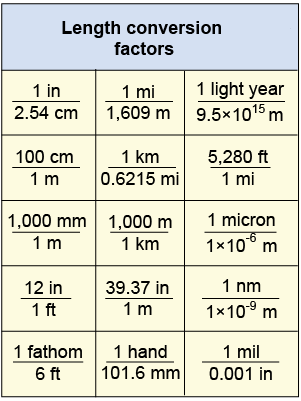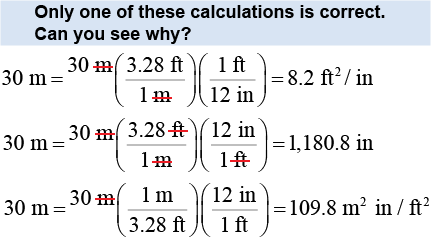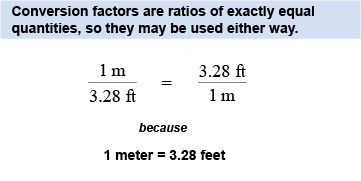|
Problem solving means using what you know to figure out something you don’t know. This skill is useful in all careers, whether for valuing a company’s stock or calculating the right size pipe to use in a new house. It is also a necessary skill to pass a physics test! One important problem solving skill is converting between two different sets of units, such as between feet and meters or between minutes and seconds. This book teaches you techniques that will help you apply your knowledge of physics to solve any problems you are likely to find in this book or on a physics exam. 
|
Converting units
|
Which is longer, 3,000 in or 100 m? The number 3,000 is larger than the number 100. Simply comparing values, however, gives you the wrong answer. To compare two lengths, both should be expressed in the same units. For example, by expressing the distance of 100 m in inches—100 m = 3,937 in—you can easily see that 100 m is longer than 3,000 in. 
| 
|
Often you will need to take a measurement in one set of units and express it in different units. This conversion is done using a relationship between units called a conversion factor (see table on the right). A conversion factor has the physical value of exactly one since the numerator and denominator represent the same distance. The numerical value of the conversion factor, however, is usually not 1.00 because the lengths are expressed in different units. 
 |
It would be much easier to do science—especially physics!—if everything was expressed in one standardized unit (such as meters). It would not, however, be easier in everyday life. The thickness of regular copy paper is 0.000076 m while the diameter of the Earth is 12,742,000 m. Neither number is very easy to understand because our brains are quickest at interpreting numbers between 1 and 1,000. To represent lengths with convenient numbers we use different units. The paper is 3 mils (0.003 in) thick. The Earth is 12,742 km in diameter. We also choose units that are easy to measure. A fathom is the distance between your outstretched hands. A sailor dropping a line can measure the depth in fathoms easily as he draws the line back in, just as a stable master can quickly size up a horse in hands. 
|
 A conversion factor has a value of one whether it is used right-side-up or upside-down. When you use the conversion factor from feet to meters you divide by 3.28; when you use the same conversion factor from meters to feet you multiply by 3.28. The correct calculation is the one in which all the units cancel except the ones you want. Once you have the conversion factors arranged so that the units work out, then you know correctly which values to multiply and which to divide by. In this example, 30 m is 1,180.8 in.
A conversion factor has a value of one whether it is used right-side-up or upside-down. When you use the conversion factor from feet to meters you divide by 3.28; when you use the same conversion factor from meters to feet you multiply by 3.28. The correct calculation is the one in which all the units cancel except the ones you want. Once you have the conversion factors arranged so that the units work out, then you know correctly which values to multiply and which to divide by. In this example, 30 m is 1,180.8 in. 
 |
 Converting units is one form of dimensional analysis because it involves the dimensions of a quantity. Dimensions are the fundamental quantities—such as mass, time, and length—that characterize our universe. Units are the different ways in which a dimension might be measured, such as inches, meters, and fathoms. For example, the diameter of the Earth has dimensions of length and therefore can be expressed in any unit of length—meters, miles, kilometers, or even inches.
Converting units is one form of dimensional analysis because it involves the dimensions of a quantity. Dimensions are the fundamental quantities—such as mass, time, and length—that characterize our universe. Units are the different ways in which a dimension might be measured, such as inches, meters, and fathoms. For example, the diameter of the Earth has dimensions of length and therefore can be expressed in any unit of length—meters, miles, kilometers, or even inches. 
|
Units are important when organizing data into tables. A standard convention is to include the units in parentheses under the name heading of each column. For example, if a column includes length data in meters, then the heading of the column should be “Length” or “l” and directly below the word “length” should be the units in parentheses (m). 
|
If you want to convert a number from meters to feet, which conversion factor would you multiply by? | a. | b. | | c. | d. |
 |
The correct answer is d. This answer has the correct conversion factor with both meters and feet, and the right side is on top. 
|
| |
|

